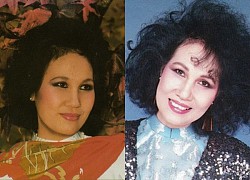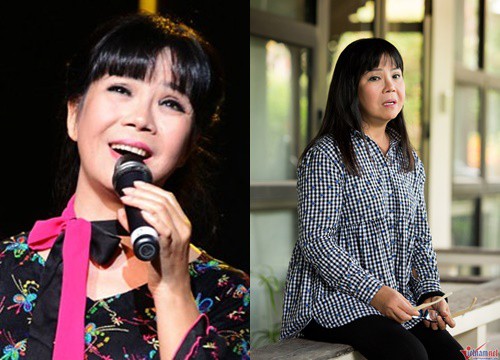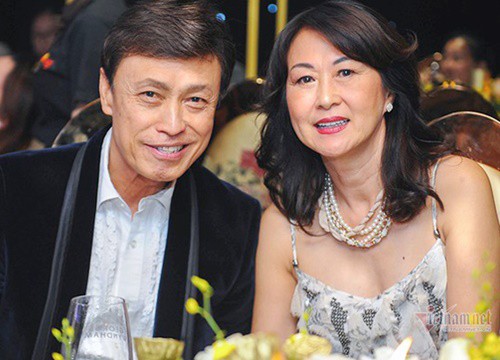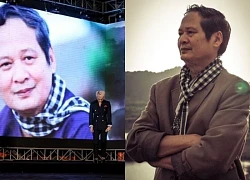Musician Bao Chan: A descendant of royalty but living a simple life and a close relationship with Trinh Cong Son

4 | 0 Discuss | Share
People's artist Thuong Huyen is likened to a torch that illuminates the way, laid the first bricks for both new music and revolutionary music, and is the muse of many great musicians.
The shining star stands between two musical streams, laying the first bricks
People's Artist Thuong Huyen, whose real name is Nguyen Thi Huong, was born in 1923 in Dan Phuong, Hanoi and from a young age was imbued with folk songs as well as northern village culture, with chants and lullabies.
Before coming to Revolutionary music, People's Artist Thuong Huyen was a big name, a bright star of early Vietnamese new music. She started singing very early, before 1945.
On that day, People's Artist Thuong Huyen and artist Mai Khanh often sang songs by Van Cao, Pham Duy... at Tan Artist, Thien Thai and created a lot of buzz. She is a rare singer who lived at the same time, talked, communicated and received new cultures with these great musicians, both in terms of poetry, music and culture of enjoyment and performance.
People's Artist Thuong Huyen is also the muse of musician Pham Duy (before Thai Thanh). Specifically, in his memoirs, Pham Duy repeatedly mentioned Thuong Huyen. He described Thuong Huyen as "a talented woman like amorous, bohemian, with a personality that doesn't care about life". Pham Duy even revealed that he and Thuong Huyen used to be lovers and loved each other deeply.
Along with Kim Tieu, Thai Thanh, People's Artist Thuong Huyen was one of the first artists to sing Van Cao's music, through songs such as Suoi Mo, Thien Thai, Vietnamese Birds...
After the August Revolution, Thuong Huyen was one of the first singers to follow the Revolution. At the Hanoi Opera House stage, she sang two songs Suoi Mo and Thien Thai at the opening ceremony of the Golden Week program and the Hunger Relief Rice Bowl launched by President Ho Chi Minh.
Thuong Huyen quickly became the leading female singer in Hanoi at this time. She sang many genres, from lyrical songs such as those of Van Cao, Trao heart (Nguyen Van Khanh), Chinh phu noi Khuc (Le Xuan Ai), Hon Vong Phu 1 (Le Thuong), Message the war hero. Artist (Doan Man)... to new revolutionary works such as Remember War Zone, Con Dao, Son La (Do Nhuan), Calling Students, Going to the Way (Luu Huu Phuoc),... With techniques With good music and skillful and sophisticated song handling, Thuong Huyen easily mastered many difficult songs in different genres.
After the outbreak of resistance against the French, Thuong Huyen joined the Liberation Theater Troupe, along with many other great trees such as Song Kim, Luu Bach Thu, Pham Van Don, Hoang Oanh, Pham Duy, Pham Dinh Viem, Van Cao, and Mai. Khanh.
She accompanied the troupe to perform in many places on battlefields and evacuation zones. In 1947, she was invited to work at the Voice of Vietnam in the Viet Bac war zone.
Here, she recorded and broadcast many songs such as Hanoi People (Nguyen Dinh Thi), Cam Tu Quan (Hoang Quy), Mo life of a soldier (Luong Ngoc Trac), Doan Ve Quoc Quan (Phan Huynh Dieu). , Song Lo, My Village, Praise to President Ho (Van Cao), Guerrilla of Thao River (Do Nhuan)... During this time, Thuong Huyen was a star at the Voice of Vietnam, with a distinctive voice. history and embrace the public.
People's Artist Thuong Huyen is a person who makes great efforts and studies hard. In order to serve the people, she went to learn more folk songs, cheo singing of old artists such as Nam Ngu, Diu Huong... Since then, Thuong Huyen brought folk singing into the Revolution. helping Revolutionary music bring a sharper and more emotional national soul. Thuong Huyen's singing is sincere, rustic and imprinted with national imprints.
After 1954, Thuong Huyen returned to Hanoi to work. She and the Hoa Binh choir went to China to record the first Vietnamese records. In 1957 during the 6th Congress of the Festival of Youth and Students held in Moscow, she won the Silver Medal at the international folk song competition. This is also the first time a Vietnamese singer has won an international award. This shows that, although Thuong Huyen is not properly trained in school, he sings quite technically and has a high level of expertise.
It can be seen that Thuong Huyen was the number one Northern folk singer in the 50s and 60s (along with Thai Thanh in the South). She is a successful performer of many songs such as: Song on Hien Luong wharf (Nguyen Tai Tue), Hanoi - Hue - Saigon (Hoang Van), Love in a card (Phan Huynh Dieu), Party is a mother. sage (Do Minh), bright moon in two regions (An Chung), bright lights on Viet Tri bridge (Hoang Ha), fast closing of good rice (Le Loi), Ru con (Southern folk song), Joyful peace. ..
Not only succeeding in her singing career, People's Artist Thuong Huyen is also the teacher of many generations of singers. With solid expertise and pioneering singing experience, she has trained many generations of excellent students such as People's Artist Le Dung, excellent teacher Ho Mo La (one of the teachers and lecturers with great contributions to the world). on classical vocal training).
The song is skillful but sincere and rustic
People's Artist Thuong Huyen possesses a light lirico soprano voice with a thin timbre and a rather high pitch. Working with great musicians such as Van Cao and Pham Duy in the early part of her career helped Thuong Huyen soon acquire some Western singing styles, combined with traditional Northern folk songs.
Thanks to that, Thuong Huyen was able to use her head voice and put it into the song smoothly. Her head voice is a pioneering head voice in the early stage of new music, when the Western vocal system has not been properly received. Therefore, Thuong Huyen does not sing the head voice of the union like later generations of singers, but uses Bach Thanh and twang.
This characteristic head voice singing style blends seamlessly with the traditional closed voice singing style, which is quite suitable for expressing folk tunes and putting it into Revolutionary music.
Thuong Huyen's voice has some similarities with Thai Thanh, high pitch, mixed voice to E5 easily. Of course, at that time, Thuong Huyen did not belting, but only used mixed voice to release each word, pronounce clearly and separate each syllable (from closed to open). There are syllables that Thuong Huyen sings on E5 mixed voice, very high compared to the usual female voice. Meanwhile, her head voice can go up to G5.
After cultivating Northern folk songs, Thuong Huyen used the vibrating technique (a typical technique of mandarins) and breathed it into Revolutionary music as well as folk songs. Thanks to that, she successfully performed many Northern folk songs, especially Bac Ninh's Quan Ho folk songs such as Drumsticks, Fragrant Flowers and Butterflies, Climbing Thien Thai Mountain, Ly Banyan... How to Vibrato Vibrato Thuong Huyen's is very characteristic, fast, bouncy and firm.
In addition, Thuong Huyen can change her voice smoothly and sweetly, leaving it in the right place and smoothly.
Thai Thanh: The female singer made Mr. Dam respect, Tran Thanh "watched for eternity"  Minh Lợi17:55:12 27/12/2022In the Vietnamese music industry, it is difficult for any singer to have as many names as Thai Thanh. Music listeners in the 60s and 70s called her "The First Singer". Music listener Pham Duy called her with the image of "The sound of crying and laughter following the fate of...
Minh Lợi17:55:12 27/12/2022In the Vietnamese music industry, it is difficult for any singer to have as many names as Thai Thanh. Music listeners in the 60s and 70s called her "The First Singer". Music listener Pham Duy called her with the image of "The sound of crying and laughter following the fate of...

4 | 0 Discuss | Share

3 | 0 Discuss | Share

4 | 0 Discuss | Share




6 | 0 Discuss | Report